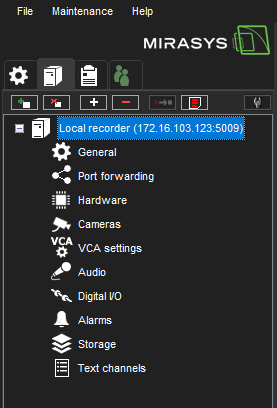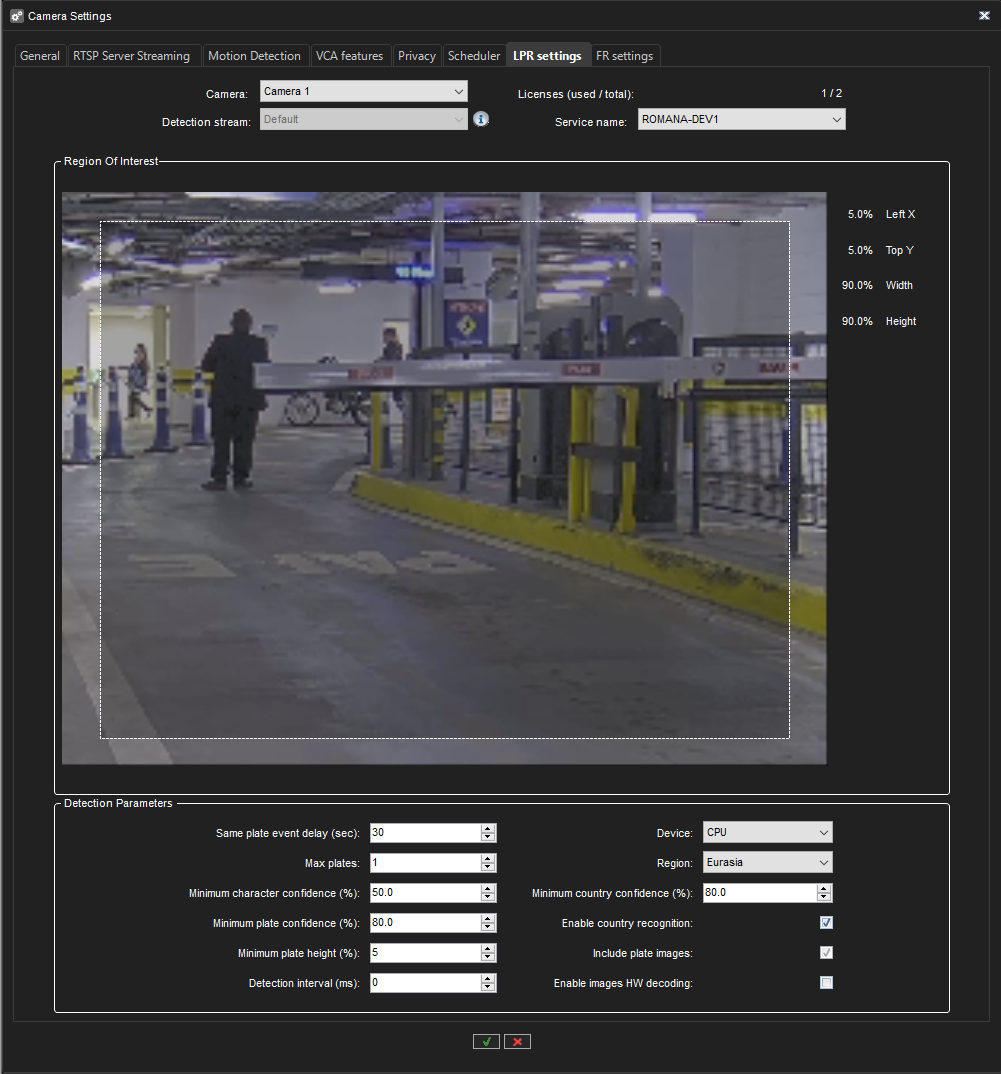The Smart LPR feature requires an RTSP Server Streaming license.
Configuration
How to configure License Plate Recognition (LPR) services via System Manager:
Open the System Manager application. The LPR settings and settings' limits start loading during the open application after inputting the login and password.
If your license does not support the Smart LPR feature, the LPR settings tab will be hidden.
Change or set LPR settings
-
To change or set LPR settings, select recorder on the VMS servers tab and open the tree node:

2. Double-click the item “Cameras” to open the Camera Settings window
3. Click on the LPR settings tab to manage LPR settings.
Please note when you double-click the item Cameras in the open Camera Settings window, your license checks for the ability to use the Smart LPR feature and generates a list of cameras (for Combobox Camera on the LPR settings tab) that are used or can be used in the LPR services.
4. When you select the LPR settings tab, the first camera from the Combobox Camera is selected.
If the selected camera can be found in services settings, the settings of this service are loaded.
Above the Service name Combobox, you will find the Licenses (used / total) Label with the number of currently used LPR licenses and total LPR licenses. When you choose a service for a camera and stream current license count is increased, and if you choose a “None” service for a camera, then the current license count is decreased.
Note: a stream is started in the Region Of Interest group area immediately after the current camera is selected in the Camera Combobox.

If no LPR service contains settings for this camera, then the “None” value is selected in the Combobox Service name, and the LPR settings are disabled.
You cannot enter service settings if RTSP streaming is not enabled for the selected camera and the stream on the RTSP Server Streaming tab. In this case RTSP streaming should be enabled for selected camera and stream for change the license plate recognition settings will appear instead of group boxes with LPR settings' controls
If the selected camera is used in some LPR service but is not allowed by the current LPR license for this service, then the Selected camera for the current service is not allowed by the license. Release LPR service for this camera or for any other camera to keep the license for this one comment will appear.
In such a case, switching the service name to the “None” value for the free license is possible.
If you need to keep the selected camera in the services settings, then should be a free license for the other camera. You need to select the other camera and switch the service name to the “None” value.
When configured licenses number equals total licenses number it is not possible to switch the service name for cameras with “None” service name value. In this case, Service name field will be disable for such cameras.
If the camera supports ANPR, you can select “Camera Engine” service in the Service name Combobox for such a camera. It means that all events created by the camera itself will be handled by the List Management service as normal LPR events.
When the “Camera Engine” service is selected, Settings for Camera Engine are configured on the camera itself will appear instead of group boxes with LPR settings' controls because, in this case, it is possible to change ANPR settings on the camera side only.
“License (used / total)” field shows how many licenses are used by LPR services and how many licenses are available. If license is unlimited “Unlimited” value is shown in this field.
Plate detection settings
After the camera, its stream and the LPR detection service are selected, license plate detection settings can be adjusted. Plate detection settings can be found in the Detection Parameters group box in the LPR settings tab in the Camera Settings window.
Plate detection settings are used for configuring the plate recognition detector.
-
Region of interest - define the area where the detections are made.
-
Same plate event delay - the number of seconds that should elapse before reading the same plate twice.
-
Max plates - maximum number of plates to detect. Detected plates are sorted by plate confidence number in descending order.
-
Minimum character confidence - plate characters recognizer confidence level. Valid values are between 25% - 95%.
-
Minimum plate confidence - recognizer confidence level. Valid values are in the range of 25% - 95%.
-
Minimum plate height - minimum plate height in %. Valid values are in the range 1% - 50%. The default value is 5%.
-
Detection interval - the number of milliseconds that describes how often plate detection is done: if it is, for example, 250ms, then plate detection is done 4 times in a second (even if the video stream frame rate is much higher, like 30 fps).
-
Device - is used for inference. Available devices depend on the hardware of the actual service.
-
Region - The detection model (Eurasia or Americas) to be used for detection.
-
Minimum country confidence - country recognizer confidence level. Valid values are between 25% - 95%.
-
Enable country recognition - enable or disable country detection. Enabling country detection can improve plate number detection in some cases.
-
Include plate images - include plate images or not in returned data.
-
Enable images HW decoding - enable to decode input images with the most suitable computing platform (CUDA, DXVA, or DirectX).
Save settings
Click the OK button with the green checkmark icon at the bottom of the Camera Settings window.
Click the Cancel button with the red cross icon to cancel saving LPR settings and return to the settings values loaded after opening the System Manager application.
LPR settings for the selected camera are temporarily saved after switching on other cameras, streams, or tabs.
If you need to delete stream settings for the selected camera and detection stream, then select “None” in the Service name Combobx for the selected camera and detection stream.
Influence on settings
The following actions affect the service settings regardless of the actions on the LPR settings tab:
-
Deleting a recorder: in case of deleting a recorder, all streams are deleted in the settings of all LPR services that worked with the remote recorder and saving the LPR settings.
-
Deleting a camera: in case of deleting a camera, the stream is deleted in the settings of all LPR services that worked with this camera and saving LPR settings. There is a rule - one camera with one stream can only be used by one LPR service, but one LPR service can work with multiple cameras.
-
Changing the image size and compression type on the Streams subtab of the General tab: in case of changing the resolution or compression type for the camera and stream, which are present in the settings of any LPR service, the LPR service settings are changed and saved when the Camera Settings window is closed.
-
Changing the RTSP streaming settings in the Streaming Settings group of the RTSP Server Streaming tab: in case of changing the "Password,” “User Name“, "RTSP Port", "Streaming Mode" (security type) for the selected camera and stream, which are present in the settings of any LPR service, the LPR service settings are changed and saved when the Camera Settings window is closed.
-
Changing the image size in the Device Settings group of the Video tab in the Hardware Settings window: in case of changing the resolution for the selected camera (here is possible to change the resolution for Recording stream only), which is present in the settings of any LPR service, the LPR service settings are changed and saved when the Hardware Settings window is closed.
-
Changing the camera by clicking on the Edit IP camera button on the Video tab in the Hardware Settings window: in case of changing the camera by clicking on the Edit IP camera button resolution and compression type for the new camera (for Recording stream only) will be rewritten in LPR services settings, where camera ID is presented, the LPR service settings are changed and saved when the Hardware Settings window is closed.
